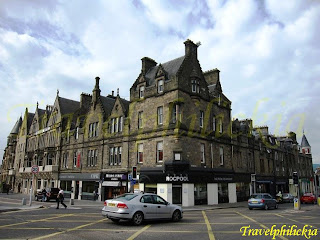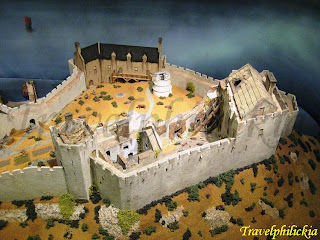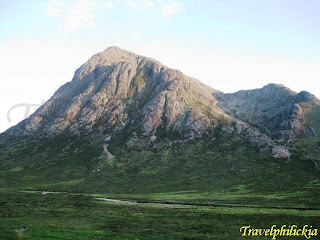Had the breakfast at Hawthorn Lodge Guest House, and next we got onto the car to explore Inverness City further.
Inverness City
Literally known as 'Mouth of the River Ness', Inverness is regarded as the capital of Scottish Highlands.
After checking with the local tourist office on some attractions, we then decided to walk around the city center (photos below) since there was a Saturday market. One of the shops was having a sale promotion, and my two colleagues were so tempted in trying out the shoes. They almost got themselves a new pair. For me the only thing I bought at Inverness was a pack of super-glue for just £ 1 at Poundland shop.


Buildings at both sides of River Ness seem to have preserved the medieval look with bricks of terra-cotta color (photos below).


One magnificent building we saw was this Inverness Castle (left photo below). Built in 1836, the red sand stone structure is located on a cliff overlooking the River Ness (right photo below). Now this castle has become the Inverness Sheriff Court.


Plantations at Scottish Highlands
We departed Inverness and headed towards Chanonry Point. Weather was good and so scenic that I took few more photos (photos below) from the moving car.


The yellowish flowers that grew throughout the plantation caught my attention (photos below). This sight is common in Europe as I saw a few while in Switzerland during this period. It was colza oil plantation that was grown for its rich oil. Colza oil is obtained from the seeds of Brassica rapa, var. oleifera. and used extensively as a lubricant for machinery.


Chanonry Point
Chanonry Point (left photo below) is reputed to be one of the best spots in the U.K. to view Bottlenose dolphin Tursiops truncatus from the land. Located at the end of Chanonry Ness, most of the land now is taken up by golf courses.
A lighthouse (right photo below) can be seen from afar situated at the tip of the point. It was first lit in 1846 and become fully automated in 1984.


Disappointedly no dolphin could be seen; we just relaxed and enjoyed the coastal view (photos below).




Lunch from Petrol Station
We bought our lunch again from the Petrol station. This time, it was cheaper compared the day before. Choice of sandwiches, bottled drink and a pack of chips cost a total of only £ 3.29. Here're two choices that we made (photos below).


Rocky cliff along the road
While driving to Loch Ness, we saw this rocky cliff that would make good photo background. Thus stopped our car and took some photos (photos below).


Loch Ness Exhibition Centre
Located at Drumnadrochit beside the Loch Ness, the Loch Ness Exhibition Center (left photo below) was opened by explorer Sir Ranulph Fiennes. The centre takes visitors through several themed areas from dawn of time to the third millennium.
Of course the focus is on the Loch Ness famous monster, also known affectionately as "Nessie". Almost 1000 reliable eye-witness and some classic photography have supported the existence of the monster. However modern scientific researches proved it otherwise. Be it hoaxes or illusions, Loch Ness has attracted many visitors to visit the lake in hoping to spot the lake monster. Perhaps disappointed visitors can get some souvenirs of the monster from this Nessie Shop (right photo below) besides the Exhibition Centre.
Admission cost to the exhibition is £ 6.50 per adult and opening hours various from 0900 to 1800 hours depending the period.


Urquhart Castle
The Urquhart Castle is located close to Drumnadrochit village, overlooking Loch Ness. The Castle witnessed considerable conflict throughout its 500 years as a medieval fortress and its history from the 13th to 17th centuries was particularly bloody. Following Edward I's invasion, it fell into English hands and was then reclaimed and lost again. In the 14th century, it figured prominently in the Scots' struggle for independence and came under the control of Robert the Bruce after he became King of Scots.
After a chequered history, the castle was blown up in 1692 to prevent it becoming a Jacobite stronghold. The ruin site was then purchased by Mr. Chewett in the 1930s and in 2003 it was gifted by his widow to The National Trust for Scotland.
Bought our admission tickets at Urquhart's Visitor Centre. Visitors would then either take a lift or walk down the stairs to the basement of the centre. Exhibition of the Urquhart Castle's history is located at its basement (left photo below). A model of the castle's former glory was displayed (right photo below). Only through the model that the functions of each hall and defense of the castle could be understood (bottom photos).




Now the place seems like a ruin site (photos below).


A re-constructed mangonel (left photo below) was on display outside the field, which was used in the medieval period to throw projectiles at a castle's walls. Visitors first have to cross over a wooden gangway (right photo below) which now lies in place of the original drawbridge across the defensive ditch.


My colleagues and I explored almost every ground of the castle ruins; walking at every corner of the site (photos below). We even climbed up the tower to have a better view of the ruins.




Besides the chapel and gatehouse, there was remain of an old kiln where grains were dried.




Opening hours from 0930 to 1800 hours (Apr to Sep), 0930 to 1700 hours (Oct), or 0930 to 1630 hours (Nov to Mar). The last admission closes 45-mins before closure time. Admission cost to the castle was £ 7 per adult.
Loch Ness
Loch Ness (photos below) is a large and deep freshwater loch in the Scottish Highlands, extending for approximately 37-km southwest of Inverness. Its deepest point is 230-meters, making it to be the largest by volume loch in Scotland. Loch Ness alone contains more fresh water than all the lakes in England and Wales combined.
Loch is an Irish and Scottish Gaelic term for a lake or a sea inlet. Loch Ness is best known for the alleged sightings of the Loch Ness Monster, "Nessie". We kept staring at the lake during our visit but weren't so lucky to see anything that resembles Nessie.




Fort William
Fort William is the second largest town in the highlands of Scotland after Inverness town. Our purpose there was not for sight-seeing, but rather to look for our dinner and hope to have a good view of Ben Nevis. We walked almost whole of Fort William high street (photos below) to search for a decent restaurant.


Takeaway Dinner
Saw this Highland Star Restaurant (left photo below) in Fort William that offers take-away. Each of us bought noodles (right photo below), and had it at a golf-course car park. I ordered Singapore Chow Mein (bottom left photo) at £ 5 and we also shared some dumplings (bottom right photo).




Ben Nevis
The best view of Ben Nevis is probably from Fort William Golf Club (left photo below). We had to walk past the golf course (right photo below) for about 5-mins from the car park before able to see Ben Nevis.


Reaching the height of 1,344-meters, Ben Nevis (left photo below) is the highest mountain in the British Isles. It has attracted and challenged many climbers and mountaineers to reach its peak for decades. Although it's already in June, there was still snow left from the spring (right photo below).


Scenes along A82 Highway
Beautiful scenes (photos below) were spotted along the A82 highway to Cumbria. We passed through the Grampian Mountain ranges, including Ben Nevis, that are occupying main belt of mountains across the centre of Scotland.




The mountains are composed mainly of granite, gneiss, marble, schists and quartzite. Interestingly, some took peculiar shape while others look like pyramid (photos below).




As it was close to sunset, the golden rays from the sun make it even more picturesque (photos below).




Along the way we saw some marshes (photos below) which reminded me of the scenes from the movie Lord of the Rings. Perhaps the author, J. R. R. Tolkien, an Oxford University Professor, got the inspiration from there when writing the Dead Marshes. The marshes in the novel were once part of an ancient battlefield, the War of the Last Alliance.




It was already 1 am when we checked in at the Guest House, Home from Home. As it had passed sleeping time, the owner of the Guest House wasn't too happy when we arrived. Nevertheless we apologized and had some wash-up before getting a good rest.
Day Five
We woke up early and departed the Guest House at about 8 am. The weather turned foggy while driving towards London.
We stopped at one of the eateries, EDC caffé (left photo below), along the highway. Ordered an English breakfast set (right photo below) at £ 6.99 for myself. Taste wasn't that bad which was similar to those we ate at the Guest Houses.


After dropping off our colleague at Stansted Airport, we then drove towards Heathrow Airport to return the car at Sixt. Next, we took the complementary shuttle to Heathrow Airport.
We shopped at the transit area of the airport before boarded the flight LX 349 back to Geneva Airport. The seat of this Swiss Air flight (left photo below) was rather comfortable compared to other budget airline seats. And light snacks of bread and drinks (right photo below) were served during this short flight.


With this, it ended my 5-days Scotland trip.
 Posts RSS
Posts RSS


